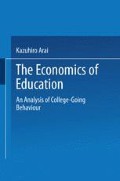Abstract
Chap. 2 argued college-going decisions based on human capital theory while Chap. 3 those based on signaling theory. These two theories have thoroughly opposed views on the purpose or function of higher education. That is, human capital theory insists that higher education enhances the productivity of students, whereas signaling theory claims that it merely conveys information to firms about the pre-college capabilities of students. As seen in Sect. 3.6, it is possible to construct a model in which higher education simultaneously performs these two different functions. However, a question may naturally arise as to which theory is more proper or which function prevails in the real economy.
Access this chapter
Tax calculation will be finalised at checkout
Purchases are for personal use only
Preview
Unable to display preview. Download preview PDF.
Notes
Criticisms similar to the second and the third can also be found in Chiswick (1973). 2 See also the study by Liu and Wong (1982) for the case of Singapore.
There are test results other than those cited here. Miller and Volker (1984) support the signaling hypothesis, while Wise (1975) and Jones and Jackson (1990) support the human capital hypothesis. See also Lazear (1977b).
In the 1980s, the United States faced a decline in the enrollment age population just as in Japan today. The population of eighteen-year-olds was 4,310 thousand in 1979 and decreased by about 20% to 3,430 thousand in 1990. Initially, there were predictions that many institutions would close or merge, but the number of institutions actually increased during this period. The following reasons are given for this (Kitamura, 1990): (a) Institutions facing this crisis cultivated potential demand for higher education. (Financial aid systems also became more extensive.) (b) They attracted female and adult students. (c) They switched from culture to practical education. (d) They adjusted study conditions to suit adult and part-time students. (e) They were active in developing revenue sources including business revenues.
Today’s diversified examination methods also affect the examination costs students bear. Because the diversification makes examination information more important, students have to bear greater costs by relying on the examination industry (preparatory schools). Further, each senior high school has become unable to provide examination information and is obliged to rely on the examination industry (Amano, 1994 ).
Author information
Authors and Affiliations
Rights and permissions
Copyright information
© 1998 Kazuhiro Arai
About this chapter
Cite this chapter
Arai, K. (1998). The Purpose and Function of Higher Education. In: The Economics of Education. Springer, Tokyo. https://doi.org/10.1007/978-4-431-66905-0_7
Download citation
DOI: https://doi.org/10.1007/978-4-431-66905-0_7
Publisher Name: Springer, Tokyo
Print ISBN: 978-4-431-66907-4
Online ISBN: 978-4-431-66905-0
eBook Packages: Springer Book Archive

